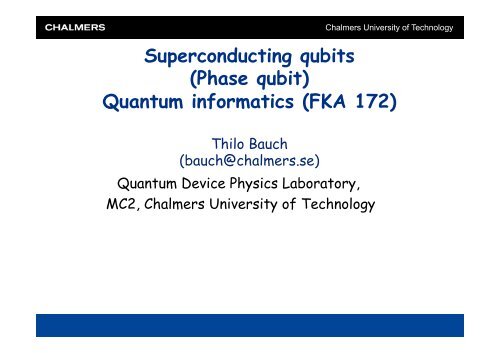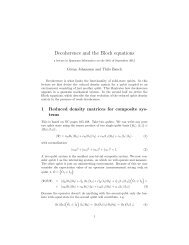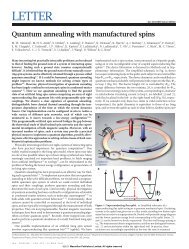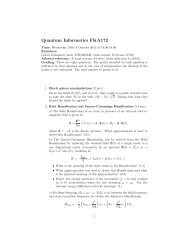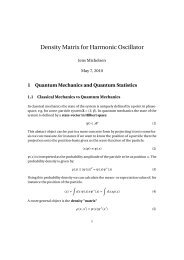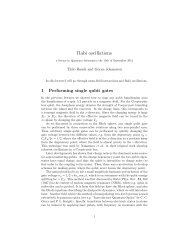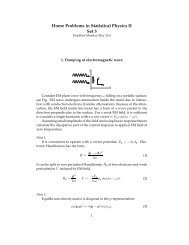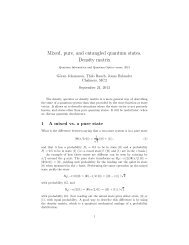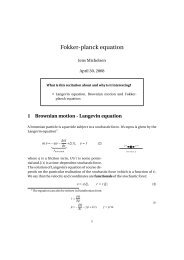Superconducting qubits (Phase qubit) Quantum informatics (FKA 172)
Superconducting qubits (Phase qubit) Quantum informatics (FKA 172)
Superconducting qubits (Phase qubit) Quantum informatics (FKA 172)
- No tags were found...
Create successful ePaper yourself
Turn your PDF publications into a flip-book with our unique Google optimized e-Paper software.
Chalmers University of Technology<strong>Superconducting</strong> <strong><strong>qubit</strong>s</strong>(<strong>Phase</strong> <strong>qubit</strong>)<strong>Quantum</strong> <strong>informatics</strong> (<strong>FKA</strong> <strong>172</strong>)Thilo Bauch(bauch@chalmers.se)<strong>Quantum</strong> Device Physics Laboratory,MC2, Chalmers University of Technology
Chalmers University of TechnologyEnergy scale of quantum integrated circuitsħω 01|1>|0>k B T
Chalmers University of TechnologyExamples of superconducting <strong><strong>qubit</strong>s</strong>charge charge/phase phasefluxNEC, Chalmers,Yale, JPLCEA SaclayTU Delft, MIT,IPHT JenaNIST,UCSB
Chalmers University of TechnologyKey ingredient: non-linear, non-dissipativeelement.Tunnel (Josephson) junctionTunnelSuperconductor 1 barrier Superconductor 2Ψ 1 =n S1/2e iθ 1 Ψ 2 =n S1/2e iθ 2x|Ψ||Ψ 1 ||Ψ 2 |x
Tunnel (Josephson) junctionJosephson equationsChalmers University of TechnologyTunnelSuperconductor 1 barrier Superconductor 2Ψ 1 =n S1/2e iθ 1 Ψ 2 =n S1/2e iθ 2Josephson 1dissipationless (Josephson) currentJosephson 2finite voltage state
Chalmers University of TechnologyJosephson inductanceAny change in Josephson current will result in a finitevoltage across the Josephson junctionThe junction acts like a (nonlinear) inductor!!
Equation of motion for the current biasedJosephson junctionChalmers University of TechnologyThe bias current splits into three currents. Fromthe currents through the resistor, capacitor, andJosephson element we get:I b R C I c or L JBy replacing the voltage across the parallel RCL Jcircuit using the second Josephson equation (see2 slides before) we get the equation of motion forthe fictitious phase particle with massproportional to the capacitance:From this equation we candirectly determine thepotential of the system U.
Chalmers University of TechnologyDynamics of the current biased Josephson junctionjunction capacitanceJosephson inductanceThe shunting admittance=(impedance) -1 is frequencydependent and accountsfor all processescausing dissipation.ω PΔUbarrierheightplasmafrequencyquality factor,only the real part of theadmittance causesdissipation
Chalmers University of TechnologyTilt of the washboardpotential is determinedby the bias currentCurrent Voltage Characteristicof a Josephson junction WITHOUT thermalor quantum fluctuations4Slope 1/R NCurrentI C32I r50 106Voltage 2Δ/eSlope of phase particletrajectory is determinedby the quality factor Q.The lower Qthe steeper the trajectory(more energy loss).
Properties of the current voltage characteristicsof a Josephson junctionChalmers University of TechnologyAmbegaokar-Baratoff:In the tunnel limit(barrier transparency
Chalmers University of Technology<strong>Superconducting</strong> QUantum Interference DeviceI b(SQUID)See T. van Duzer, “Principles ofSuperconductive Devices and Circuits”, 2nd edition,Prentice Hall
Escape mechanisms from V=0 to V=0Thermal ActivationChalmers University of TechnologyΔUH.A. Kramers, Pysica 7, 284 (1940)Macroscopic <strong>Quantum</strong> Tunnelingcross over temperatureA.O. Caldeira, A.J. Leggett, PRL 46, 211 (1981)
Current Voltage Characteristicof a Josephson junction WITH thermalor quantum fluctuationsChalmers University of TechnologyCurrentswitching current I S
Chalmers University of TechnologySwitching probability from V=0 to V=0Probability to switch after(small) time interval dtHere and stands for thermal orquantum escape rateProbability to switch in timeinterval between t and t+dtProbability NOT to switchup to time tI bBias junction at a fixed current < I C and wait untiljunction switches and measure time differenceI CVt 0 =0t Sttrepeat10000 times+histogramt 0
Chalmers University of TechnologyProbability to switch during a current pulse ofheight I and widthI bFix current pulse length and height (
Energy levels in tilted washboard potentialIc=3.9 µA C=3.1 pF I b /I C =0.977Chalmers University of TechnologyFor bias currents close to the critical current we canapproximate the system by a two level system!!
Macroscopic quantum tunneling ratesChalmers University of Technology10Possibility to distinguish between 0 and 1 state!!
Chalmers University of TechnologyAt the working pointthe barrier height islarge enough toprevent the phaseparticle to escape thematastable wellMeasurement of Rabi oscillationsHarmonic mw signal Bias current I bI C00Working pointcurrent pulseRead out pulsetimetimeAt the measuring point thebarrier is lowered by applying ashort dc current pulse on topof the long bias current pulse.If <strong>qubit</strong> is in state 1: switching(escape of phase particle)probability is very high.If <strong>qubit</strong> is in state 0:Switching probability is verylow.For a fixed microwavepulse length repeatsequence 5000 times toaccumulate statistics
Chalmers University of TechnologySpectroscopy, relaxation time and Rabioscillations using magnetic flux read out pulse10J. Claudon Phys. Rev. Lett. 93, 187003, (2004)
Chalmers University of TechnologySchematics of switching event measurementpulse
Chalmers University of Technology3He- 4 He dilution refrigeratorGas handling panelBase temperature T=15 mKQubit frequency:GHz (275 mK)
Qubit: Nb/AlO x /Nb SQUIDChalmers University of TechnologySQUID5 mmMagnetic fluxlineDC bias current
Chalmers University of TechnologycomparatorDC current pulseDC flux pulse + MWshaping pulseMWsourceCounter(events+ timedifference)mixerPowercombiner/divider
Chalmers University of TechnologyMeasure probability for the SQUID/junction to switch in time interval t andt+dt as a function of bias current, when the SQUID/junction is in the groundstateMeasure the relaxation time T 1 of the first excited state for a fixed biascurrentMeasure Rabi oscillations for a fixed bias current; determine roughly thedriven coherence time.


